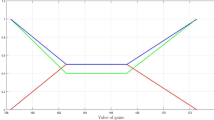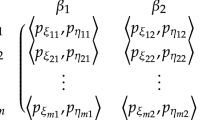Abstract
Single-valued neutrosophic numbers (SVNNs) are very much useful to express uncertain environments. In real-life problems, there are many situations where players of a matrix game can not assess their payoffs by using ordinary fuzzy sets or intuitionistic fuzzy sets. In these situations, single-valued trapezoidal neutrosophic numbers (SVTNNs) play a vital role in game theory, as it includes indeterminacy in the information besides truth and falsity. The objectives of this paper are to explore matrix games with SVTNN payoffs and to investigate two different solution methodologies. To solve such games, a pair of neutrosophic mathematical programming problems have been formulated. In the first approach, the two neutrosophic mathematical programming models are converted into interval-valued multi-objective programming problems by using a new ranking order relation of SVTNNs. Finally, the reduced problems are solved using the weighted average approach and utilizing LINGO 17.0 software. It is worth mentioning that the values of the game for both the players are obtained in SVTNN forms, which is desirable. In the second approach, each neutrosophic mathematical programming model is transformed into a crisp one by using the idea of \(\alpha \)-weighted possibility mean value for SVTNNs. A market share problem and another numerical example are illustrated to show the validity and applicability of the proposed approaches.



Similar content being viewed by others
References
Atanassov KT (1999) Intuitionistic fuzzy sets: theory and applications. Physica- Verlag, Heidelberg
Bector CR, Chandra S (2005) Fuzzy mathematical programming and fuzzy matrix games, vol 169. Springer Verlag, Berlin
Bhaumik A, Roy SK, Li DF (2017) Analysis of triangular intuitionistic fuzzy matrix games using robust ranking. J Intell Fuzzy Syst 33(1):327–336
Bhaumik A, Roy SK, Weber GW (2020) Hesitant interval-valued intuitionistic fuzzy-linguistic term set approach in prisoners’ dilemma game theory using TOPSIS: a case study on human-trafficking. Cent Eur J Op Res 28(2):797–816
Bhaumik A, Roy SK, Weber GW (2021) Multi-objective linguistic-neutrosophic matrix game and its application to tourism management. J Dyn Games 8(2):101–118
Bhaumik A, Roy SK, Li DF (2021) (\(\alpha , \beta , \gamma \))-cut set based ranking approach to solving bi-matrix games in neutrosophic environment. Soft Comput 25(4):2729–2739
Bhaumik A, Roy SK (2021) Intuitionistic interval-valued hesitant fuzzy matrix games with a new aggregation operator for solving management problem. Granul Comput 6(2):359–375
Biswas P, Pramanik S, Giri BC (2016) TOPSIS method for multi-attribute group decision making under single-valued neutrosophic environment. Neural Comput Appl 27(3):727–737
Campos L, Gonzalez A, Vila MA (1992) On the use of the ranking function approach to solve fuzzy matrix games in a direct way. Fuzzy Sets Syst 49(2):193–203
Das BC, Roy SK (2013) Fuzzy based GA to multi-objective entropy bimatrix game. Opsearch 50(1):125–140
Deli I (2019) Matrix games with simplified neutrosophic payoffs. In: Kahraman C, Otay I (eds) Fuzzy Multi-criteria decision-making using neutrosophic sets: studies in fuzziness and soft computing. Springer, Cham, pp 233–246
Deli I, Subas Y (2017) A ranking method of single-valued neutrosophic numbers and its application to multi-attribute decision making problems. Int J Mach Learn Cybern 8(4):1309–1322
Garai T, Garg H, Roy TK (2020) A ranking method based on possibility mean for multi-attribute decision making with single-valued neutrosophic numbers. J Ambient Intell Humaniz Comput 11:5245–5258
Garg H (2020) Algorithms for single-valued neutrosophic decision making based on TOPSIS and clustering methods with new distance measure. AIMS Math 5(3):2671–2693
Ishibuchi H, Tanaka H (1990) Multiobjective programming in optimization of the interval objective function. Eur J Op Res 48(2):219–225
Jana J, Roy SK (2018) Solution of matrix games with generalized trapezoidal fuzzy payoffs. Fuzzy Inf Eng 10(2):213–224
Jana J, Roy SK (2019) Dual hesitant fuzzy matrix games: based on new similarity measure. Soft Comput 23(18):8873–8886
Karmakar S, Seikh MR, Castillo O (2021) Type-2 fuzzy matrix games based on a new distance measure: application to biogas-plant implementation problem. Appl Soft Comput. https://doi.org/10.1016/j.asoc.2021.107357
Li DF (2014) Decision and game theory in management with intuitionistic fuzzy sets. Springer-Verlag, Berlin, p 308
Li DF (2012) A fast approach to compute fuzzy values of matrix games with payoffs of triangular fuzzy numbers. Eur J Op Res 223(2):421–429
Li DF (2013) An effective methodology for solving matrix games with fuzzy pay-offs. IEEE Trans Cybern 43(2):610–621
Li DF (2016) Linear programming models and methods of matrix games with payoffs of triangular fuzzy numbers, vol 328. Springer-Verlag, Heidelberg
Moore RE (1979) Method and application of interval analysis. SIAM, Philadelphia
Nan JX, Zhang MJ, Li DF (2014) A methodology for matrix games with pay-offs of triangular intuitionistic fuzzy number. J Intell Fuzzy Syst 26(6):2899–2912
Owen G (1982) Game theory. Academic Press, New York
Roy SK, Mula P (2016) Solving matrix game with rough payoffs using genetic algorithm. Int J Op Res 16(1):117–130
Roy SK, Bhaumik A (2018) Intelligent water management: a triangular type-2 intuitionistic fuzzy matrix games approach. Water Resour Manag 32(3):949–968
Roy SK, Maiti SK (2020) Reduction methods of type-2 fuzzy variables and their applications to Stackelberg game. Appl Intell 50:1398–1415
Seikh MR, Nayak PK, Pal M (2015) Application of intuitionistic fuzzy mathematical programming with exponential membership and quadratic non-membership functions in matrix games. Ann Fuzzy Math Inform 9(2):183–195
Seikh MR, Nayak PK, Pal M (2015) Matrix game with intuitionistic fuzzy pay-offs. J Inf Optim Sci 36(1–2):159–181
Seikh MR, Nayak PK, Pal M (2015) An alternative approach for solving fuzzy matrix games. Int J Math Soft Comput 5(1):79–92
Seikh MR, Nayak PK, Pal M (2016) Aspiration level approach to solve matrix games with I-fuzzy goals and I-fuzzy pay-offs. Pac Sci Rev: A natural Sci Eng 18(1):5–13
Seikh MR, Karmakar S, Xia M (2020) Solving matrix games with hesitant fuzzy pay-offs. Iran J Fuzzy Syst 17(4):25–40
Seikh MR, Karmakar S, Castillo O (2021) A novel defuzzification approach of type-2 fuzzy variable to solving matrix games: an application to plastic ban problem. Iran J Fuzzy Syst 18(5):155–172
Seikh MR, Dutta S, Li DF (2021) Solution of matrix games with rough interval pay-offs and its application in the telecom market share problem. Int J Intell Syst 36:6066–6100
Seikh MR, Karmakar S, Nayak PK (2021) Matrix games with dense fuzzy payoffs. Int J Inteill Syst 36(4):1770–1799
Selvachandran G, Quek SG, Smarandache F, Broumi S (2018) An extended technique for order preference by similarity to an ideal solution (TOPSIS) with maximizing deviation method based on integrated weight measure for single-valued neutrosophic sets. Symmetry 10(7):236
Smarandache F (1998) A unifying field in logics. Neutrosophy: neutrosophic probability, set and logic. American Research Press, Rehoboth
Sodenkamp MA, Tavana M, Di Caprio D (2018) An aggregation method for solving group multi-criteria decision-making problems with single-valued neutrosophic sets. Appl Soft Comput 71:715–727
Subas Y (2015) Neutrosophic numbers and their application to Multi-attribute decision making problems, Masters Thesis, Kilis 7 Aralik University, Graduate School of Natural and Applied Sciences,
Verma T, Kumar A (2020) Matrix games with fuzzy payoffs. In: Fuzzy solution concepts for non-cooperative games. Studies in fuzziness and soft computing, vol 383. Springer, Cham. https://doi.org/10.1007/978-3-030-16162-0_2
Wang H, Smarandache F, Zhang YQ, Sunderraman R (2010) Single valued neutrosophic sets. Multispace Multistructure 4:410–413
Wei G, Wei Y (2018) Some single-valued neutrosophic dombi prioritized weighted aggregation operators in multiple attribute decision making. J Intell Fuzzy Syst 35(2):2001–2013
Xia M (2019) Methods for solving matrix games with cross-evaluated pay-offs. Soft Comput 23(21):11123–11140
Xing Y, Qiu D (2019) Solving traingular intuitionistic fuzzy matrix game by applying the accuracy function method. Symmetry 11(10):1258
Xue W, Xu Z, Zeng XJ (2020) Solving matrix games based on Ambika method with hesitant fuzzy information and its application in the counter-terrorism issue. Appl Intell 51(3):1227–1243
Ye J (2014) Single-valued neutrosophic minimum spanning tree and its clustering method. J Intell Syst 23(3):311–324
Ye J (2014) Vector similarity measures of simplified neutrosophic sets and their application in multicriteria decision-making. Int J Fuzzy Syst 16(2):204–211
Ye J (2015) Trapezoidal neutrosophic set and its application to multiple attribute decision-making. Neural Comput Appl 26:1157–1166
Acknowledgements
The authors would like to thank the anonymous reviewers for their valuable comments and constructive suggestions to improve the quality of the presentation of the paper.
Author information
Authors and Affiliations
Ethics declarations
Conflict of interest
The authors declare that they have no conflict of interest.
Human and animal rights statement
This article does not contain any studies with human participants or animals performed by any of the authors.
Additional information
Publisher's Note
Springer Nature remains neutral with regard to jurisdictional claims in published maps and institutional affiliations.
Rights and permissions
About this article
Cite this article
Seikh, M.R., Dutta, S. Solution of matrix games with payoffs of single-valued trapezoidal neutrosophic numbers. Soft Comput 26, 921–936 (2022). https://doi.org/10.1007/s00500-021-06559-7
Accepted:
Published:
Issue Date:
DOI: https://doi.org/10.1007/s00500-021-06559-7




